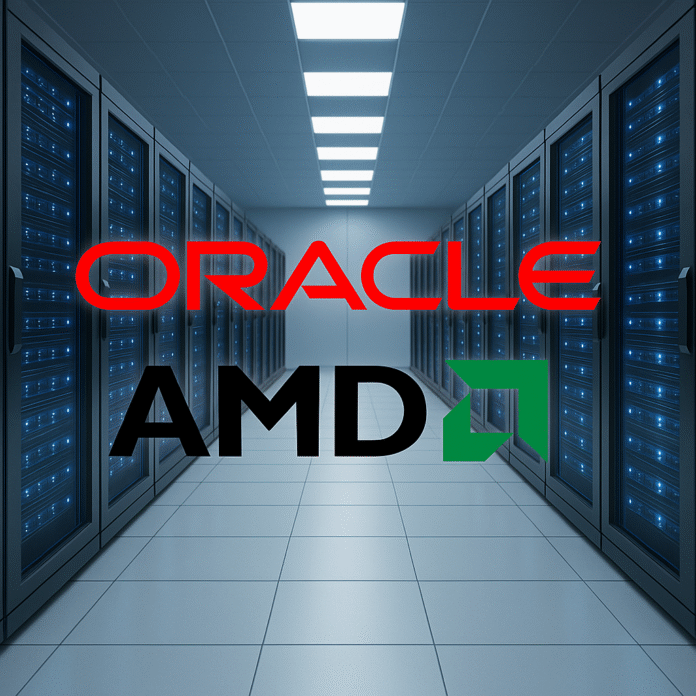In a landmark announcement on October 14, 2025, Oracle Corporation (Oracle) and Advanced Micro Devices, Inc. (AMD) unveiled an ambitious expansion of their long‑standing partnership. The companies revealed that Oracle’s cloud‑unit, Oracle Cloud Infrastructure (OCI), will be the first hyperscaler to offer a publicly available AI supercluster powered by 50,000 AMD Instinct MI450 Series GPUs, beginning in calendar Q3 2026, with further scaling through 2027 and beyond. Oracle+2PR Newswire+2
This is not just a numbers game. The MI450 Series GPUs, developed by AMD, bring high‑end features tailored for extreme scale AI workloads: each MI450 unit offers up to 432 GB of HBM4 memory and delivers 20 TB/s of memory bandwidth—enabling models roughly 50 % larger than prior generations to be trained or inferred entirely in‑memory. PR Newswire+2Data Center Dynamics+2
Alongside the GPU rollout, Oracle and AMD will deploy a vertically optimized rack architecture dubbed “Helios,” integrating next‑gen AMD EPYC CPUs (codenamed “Venice”), advanced AMD Pensando networking (codenamed “Vulcano”), liquid cooling, and an open interconnect fabric (UALink/UALoE) for coherent GPU‑to‑GPU communication.
Strategic significance
This deal underscores several evolving dynamics in the cloud and AI infrastructure market:
1. Supply‑chain diversification:
For Oracle, locking in a 50K‑GPU deployment with AMD helps reduce dependence on any single vendor and positions OCI to compete more aggressively with rivals such as Amazon Web Services, Microsoft Corporation and Google LLC in the AI‑compute race.
2. AMD’s growing cloud footprint:
AMD’s chip footprint in the hyperscale AI market has been steadily increasing—and this deal is a high‑profile endorsement. The sheer size of the rollout signals that AMD intends to challenge the dominant GPU incumbents in a meaningful way. Open Data Science+1
3. AI model demands shifting scale:
Next‑generation large‑language models (LLMs), multi‑modal architectures and inference‑at‑massive‑scale scenarios are pushing infrastructure demands past traditional cluster designs. The MI450’s memory and bandwidth capabilities appear tailored for exactly that. CloudNews.Tech+1
What this means for customers
If you’re a business building or deploying AI models—whether for data‑science pipelines, generative AI, or inference at scale—this announcement signals:
-
Access to infrastructures that support larger models without aggressive partitioning, thanks to higher‑capacity memory per GPU (432 GB). PR Newswire+1
-
Potentially improved cost or performance per model if Oracle’s pricing and availability scale as promised—especially relative to earlier era clusters that were scaled horizontally.
-
Open‑stack flexibility: AMD emphasizes support for open‑source tooling (ROCm, etc.), which may appeal to users seeking alternatives to proprietary stacks. Oracle+1
Challenges and caveats
-
The deployment is slated to begin Q3 2026, meaning this is forward‑looking rather than immediately available. Early adopters will have to wait. Oracle+1
-
Scaling infrastructure is one thing; ecosystem, software optimization, and operational readiness are another. The promise of architecture is strong—but realization will require tight coordination.
-
Competition remains fierce: other cloud providers may unveil comparable builds, and vendor dynamics (supply, customization, exclusivity) will matter.
Closing thoughts
This alliance between Oracle and AMD marks a clear milestone in the evolving AI‑cloud landscape. At a time when demand for compute is surging, both companies appear to be stepping up to meet it—not just with incremental upgrades, but with wholesale architectural leaps. For organizations designing large‑scale AI systems, this signals that the on‑premises “supercluster” paradigm is moving into the public‑cloud domain more aggressively than ever.
That said, the ultimate test will come in deployment, availability, ecosystem maturity and cost‑effectiveness. The headline “50,000 GPUs” is impressive, yet value will really be defined by how enterprises and enterprises’ AI workloads benefit in practice from this infrastructure.
In short: if you’re serious about next‑generation AI at scale, this Oracle/AMD build is one to watch—but it’s not yet the finish line, just a very bold step toward it.
References
-
Oracle and AMD Expand Partnership to Help Customers Achieve Next‑Generation AI Scale, Press Release, Oracle News (Oct 14, 2025) — Title; Category: Press Release; URL: https://www.oracle.com/news/announcement/ai-world-oracle-and-amd-expand-partnership-to-help-customers-achieve-next-generation-ai-scale-2025-10-14/
- Oracle to deploy cluster of 50,000 AMD Instinct MI450 GPUs, DCD News (Oct 14, 2025) — Title; Category: News; URL: https://www.datacenterdynamics.com/en/news/oracle-to-deploy-cluster-of-50000-amd-instinct-mi450-gpus/
- Oracle and AMD expand their partnership: first public AI supercluster with 50,000 AMD Instinct MI450 GPUs on OCI, CloudNews.tech (Oct 14, 2025) — Title; Category: News; URL: https://cloudnews.tech/oracle-and-amd-expand-their-partnership-first-public-ai-supercluster-with-50000-amd-instinct-mi450-gpus-on-oci-starting-in-2026-on-the-rack-scale-helios-platform/
Serge Boudreaux – AI Hardware Technologies
Montreal, Quebec
Peter Jonathan Wilcheck – Co-Editor
Miami, Florida
Post Disclaimer
The information provided in our posts or blogs are for educational and informative purposes only. We do not guarantee the accuracy, completeness or suitability of the information. We do not provide financial or investment advice. Readers should always seek professional advice before making any financial or investment decisions based on the information provided in our content. We will not be held responsible for any losses, damages or consequences that may arise from relying on the information provided in our content.



